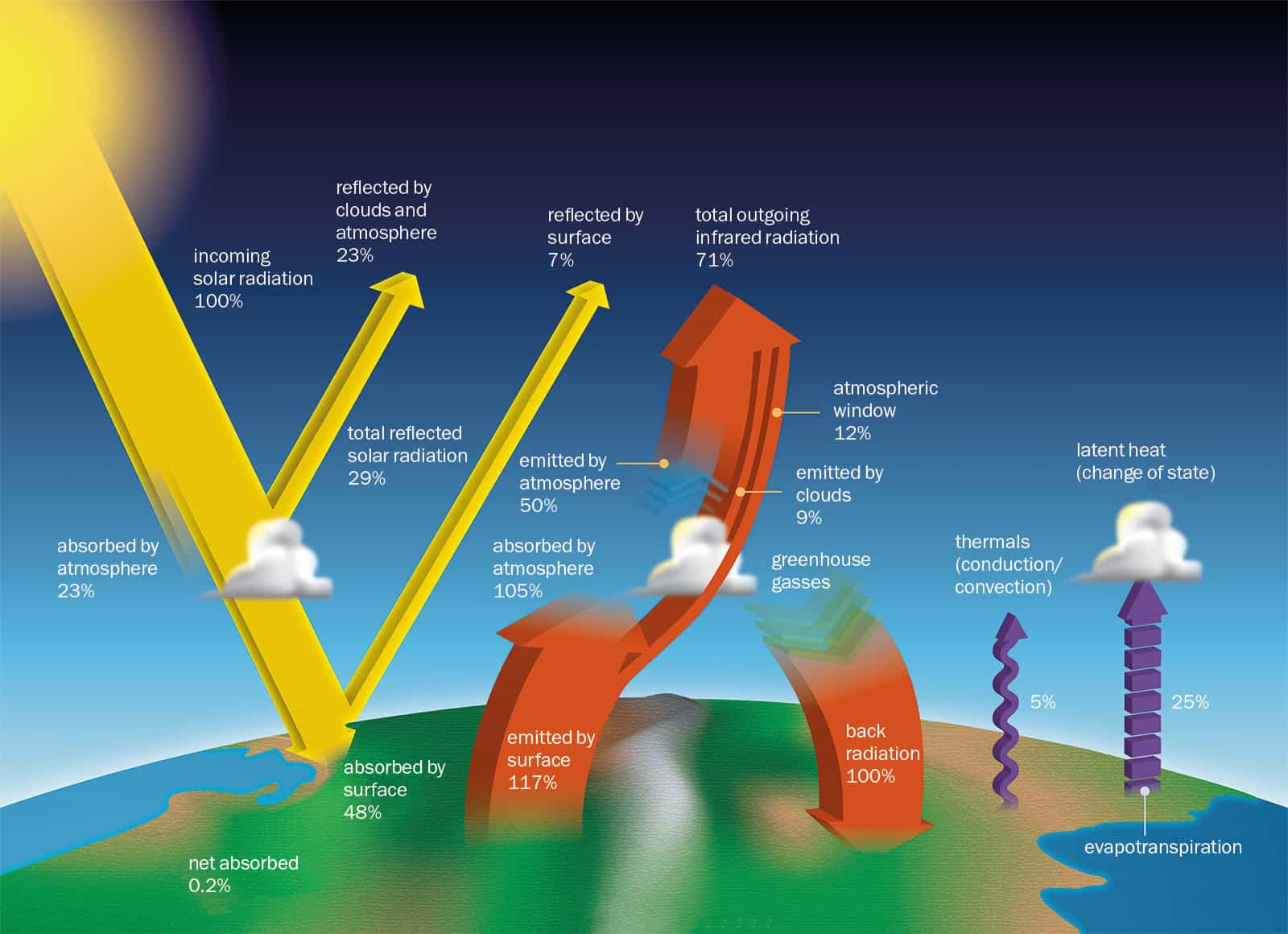For all of us concerned about the climate, 2023 was a grim year. One of the biggest uncertainties in predicting future climate change is the impact of clouds. Michael Allen speaks to the physicists and atmospheric scientists studying the properties and processes of cloud physics – from structure and phase-transitions to modelling and manipulations
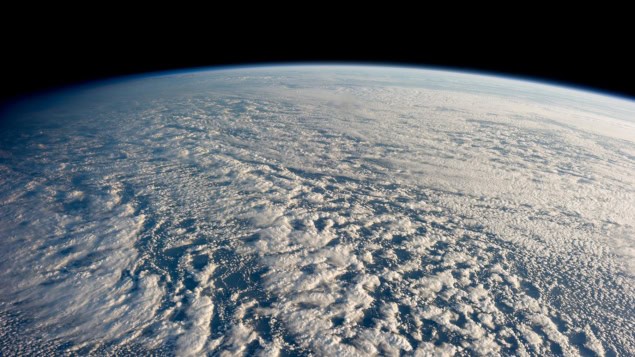
For all of us concerned about climate change, 2023 was a grim year. According to the World Meteorological Organisation (WMO), it was the warmest year documented so far, with records broken – and in some cases smashed – for ocean heat, sea-level rise, Antarctic sea-ice loss and glacier retreat.
Capping off the warmest 10-year period on record, global average near-surface temperature hit 1.45 °C above pre-industrial levels. “Never have we been so close – albeit on a temporary basis at the moment – to the 1.5 °C lower limit of the Paris Agreement on climate change,” said WMO secretary-general Celeste Saulo in a statement earlier this year.
The heatwaves, floods, droughts and wildfires of 2023 are clear signs of the increasing dangers of the climate crisis. As we look to the future and wonder how much the world will warm, accurate climate models are vital.
For the physicists who build and run these models, one major challenge is figuring out how clouds are changing as the world warms, and how those changes will impact the climate system. According to the Intergovernmental Panel on Climate Change (IPCC), these feedbacks create the biggest uncertainties in predicting future climate change.
Cloud cover, high and low
Clouds play a key role in the climate system, as they have a profound impact on the Earth’s radiation budget. That is the balance between the amount of energy coming in from solar radiation, and the amount of energy going back out to space, which is both the reflected (shortwave) and thermal (longwave) energy radiated from the Earth.
According to NASA, about 29% of solar energy that hits Earth’s atmosphere is reflected back into space, primarily by clouds (figure 1). And clouds also have a greenhouse effect, warming the planet by absorbing and trapping the outgoing thermal radiation.
1 Earth’s energy budget
How energy flows into and away from the Earth. Based on data from multiple sources including NASA’s CERES satellite instrument, which measures reflected solar and emitted infrared radiation fluxes. All values are fluxes in watts per square metre and are average values based on 10 years of data. First published in 2014.
“Even a subtle change in global cloud properties could be enough to have a noticeable effect on the global energy budget and therefore the amount of warming,” explains climate scientist Paulo Ceppi of Imperial College London, who is an expert on the impact of clouds on global climate.
A key factor in this dynamic is “cloud fraction” – a measurement that climate scientists use to determine the percentage of the Earth covered by clouds at a given time. More specifically, it’s the portion of the Earth’s surface covered by cloud, relative to the portion that is uncovered. Cloud fraction is determined via satellite imagery and is the portion of each pixel (1-km-pixel resolution cloud mask) in an image that is covered by clouds (figure 2).
Apart from the amount of cover, what also matter are the altitude of clouds and their optical thickness. Higher, cooler clouds absorb more thermal energy originating from the Earth’s surface, and therefore have a greater greenhouse warming effect than low clouds. They also tend to be thinner, so they let more sunlight through and overall have a net warming effect. Low clouds, on the other hand, have a weak greenhouse effect, but tend to be thicker and reflect more solar radiation. They generally have a net cooling effect.
2 Cloud fraction
These maps show what fraction of an area was cloudy on average each month, according to measurements collected by the Moderate Resolution Imaging Spectroradiometer (MODIS) on NASA’s Terra satellite. MODIS collects information in gridded boxes, or pixels. Cloud fraction is the portion of each pixel that is covered by clouds. Colours range from blue (no clouds) to white (totally cloudy).
The band of persistent clouds around the equator is the Intertropical Convergence Zone – where the easterly trade winds in the Northern and Southern Hemispheres meet, pushing warm, moist air high into the atmosphere. The air expands and cools, and the water vapour condenses into clouds and rain. The cloud band shifts slightly north and south of the equator with the seasons. In tropical countries, this shifting of the zone is what causes rainy and dry seasons.
Video and data courtesy: NASA Earth Observations
As the climate warms, cloud properties are changing, altering the radiation budget and influencing the amount of warming. Indeed, there are two key changes: rising cloud tops and a reduction in low cloud amount.
The most understood effect, Ceppi explains, is that as global temperatures increase, clouds rise higher into the troposphere, which is the lowermost atmospheric layer. This is because as the troposphere warms it expands, increasing to greater altitudes. Over the last 40 years the top of the troposphere, known as the tropopause, has risen by about 50 metres per decade (Sci. Adv. 10.1126/sciadv.abi8065).
“You are left with clouds that rise higher up on average, so have a greater greenhouse warming effect,” Ceppi says. He adds that modelling data and satellite observations support the idea that cloud tops are rising.
Conversely, coverage of low clouds, which reflect sunlight and cool the Earth’s surface, is decreasing with warming. This reduction is mainly in marine low clouds over tropical and subtropical regions. “We are talking a few per cent, so not something that you would necessarily notice with your bare eyes, but it’s enough to have an effect of amplifying global warming,” he adds.
These changes in low clouds are partly responsible for some of the extreme ocean heatwaves seen in recent years (figure 3). While the mechanisms behind these events are complex, one known driver is this reduction in low cloud cover, which allows more solar radiation to hit the ocean (Science 325 460).
“It’s cloud feedback on a more local scale,” Ceppi says. “So, the ocean surface warms locally and that prompts low cloud dissipation, which leads to more solar radiation being absorbed at the surface, which prompts further warming and therefore amplifies and sustains those events.”
3 Ocean heat
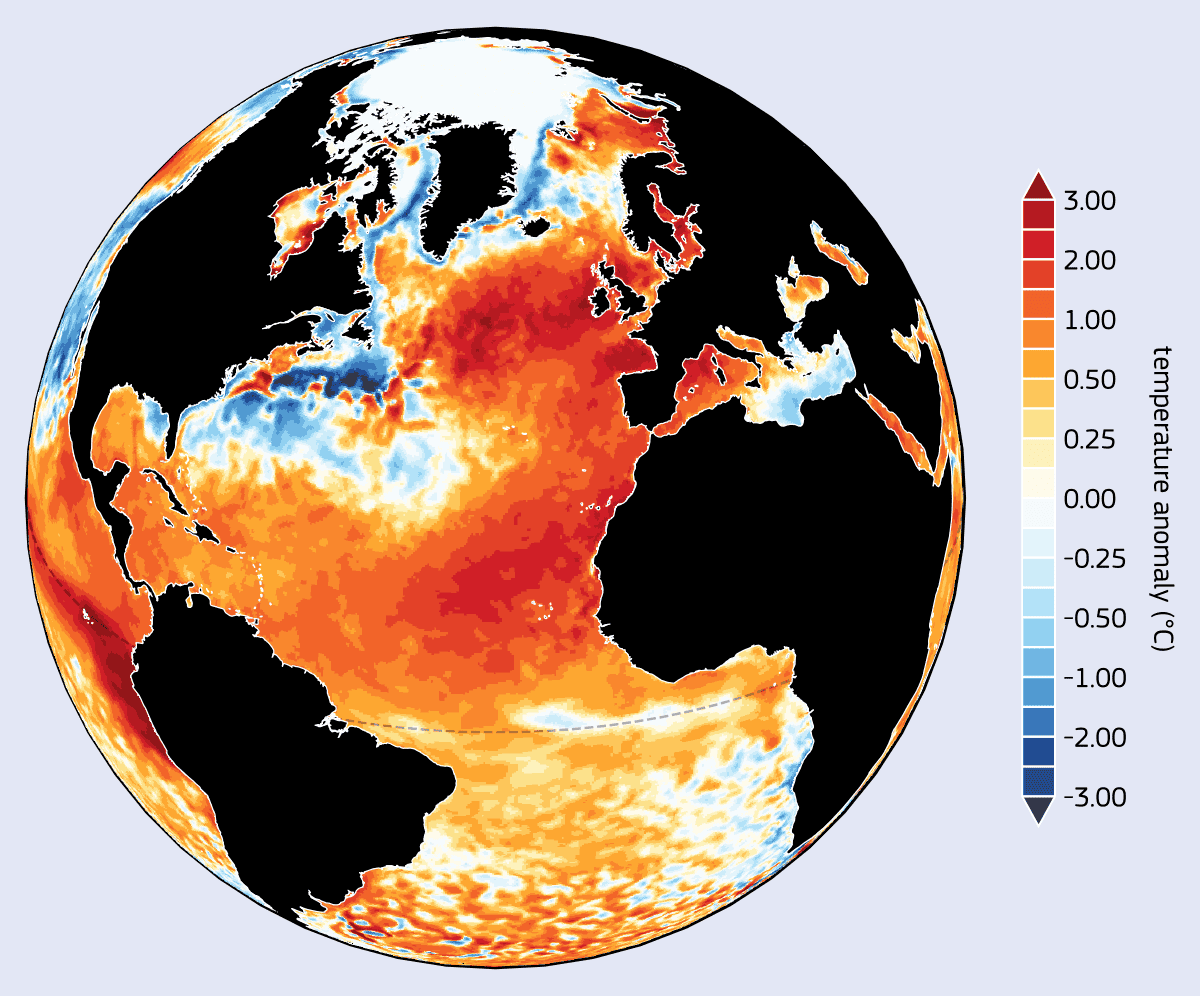
Sea surface temperature anomaly (°C) for the month of June 2023, relative to the 1991–2020 reference period. The global ocean experienced an average daily marine heatwave coverage of 32%, well above the previous record of 23% in 2016. At the end of 2023, most of the global ocean between 20° S and 20° N had been in heatwave conditions since early November.
Despite these insights, several questions remain unanswered. For example, Ceppi explains that while we know that low cloud changes will amplify warming, the strength of these effects needs further investigation, to reduce the uncertainty range.
Also, as high clouds move higher, there may be other important changes, such as shifts in optical thickness, which is a measure of how much light is scattered or absorbed by cloud droplets, instead of passing through the atmosphere. “We are a little less certain about what else happens to [high clouds],” says Ceppi.
Diurnal changes
It’s not just the spatial distribution of clouds that impacts climate. Recent research has found an increasing asymmetry in cloud-cover changes between day and night. Simply put, daytime clouds tend to cool Earth’s surface by reflecting solar radiation, while at night clouds trap thermal radiation and have a warming effect. This shift in diurnal distribution could create a feedback loop that amplifies global warming.
The new study was led by theoretical meteorologist Johannes Quaas at Leipzig University, together with Hao Luo and Yong Han from Sun Yat-sen University in China, who found that as the climate warms, cloud cover – especially in the lower atmosphere – decreases more during the day than at night (Sci. Adv. 10.1126/sciadv.ado5179).
By analysing satellite observations and data from the sixth phase of the Coupled Model Intercomparison Project (CMIP6) – which incorporates historical data collected between 1970 and 2014 as well as projections up to the year 2100 – the researchers concluded that this diurnal asymmetry is largely due to rising concentrations of greenhouse gases that make the lower troposphere more stable, which in turn increases the overall heating.
Fewer clouds form during the day, thereby reducing the amount of shortwave radiation that is reflected away. Night-time clouds are more stable, which in turn increases the longwave greenhouse effect. “Our study shows that this asymmetry causes a positive feedback loop that amplifies global warming,” says Quaas. This growing asymmetry is mainly driven by a daytime increase in turbulence in the lower troposphere as the climate warms, meaning that clouds are less likely to form and remain stable during the day.
Mixed-phase clouds
Climate models are affected by more than just the distribution of clouds in space. What also matters is the distribution of liquid water and ice within clouds. In fact, researchers have found that the way in which models simulate this effect influences their predictions of warming in response to greenhouse gas emissions.
So-called “mixed-phase” clouds are those that contain water vapour, ice particles and supercooled liquid droplets, and exist in a three-phase colloidal system. Such clouds are ubiquitous in the troposphere. These clouds are found at all latitudes from the polar regions to the tropics and they play an important role in the climate system.
As the atmosphere warms, mixed-phase clouds tend to shift from ice to liquid water. This transition makes these clouds more reflective, enhancing their cooling effect on the Earth’s surface – a negative feedback that dampens global warming.
In 2016 Trude Storelvmo, an atmospheric scientist at the University of Oslo in Norway, and her colleagues made an important discovery: many climate models overestimate this negative feedback (Geophys. Res. Lett. 10.1029/2023GL105053). Indeed, the models often simulate clouds with too much ice and not enough liquid water. This error exaggerates the cooling effect from the phase transition. Essentially, the clouds in these simulations have too much ice to lose, causing the models to overestimate the increase in their reflectiveness as they warm.
One problem is that these models oversimplify cloud structure, failing to capture the true heterogeneity of mixed-phase clouds. Satellite, balloon and aircraft observations reveal that these clouds are not uniformly mixed, either vertically or horizontally. Instead, they contain pockets of ice and liquid water, leading to complex interactions that are inadequately represented in the simulations. As a result, they overestimate ice formation and underestimate liquid cloud development.
Storelvmo’s work also found that initially, increased cloud reflectivity has a strong effect that helps mitigate global warming. But as the atmosphere continues to warm, the increase in reflectiveness slows. This shift is intuitive: as the clouds become more liquid, they have less ice to lose. At some point they become predominantly liquid, eliminating the phase transition. The clouds cannot become anymore liquid – and thus reflective – and warming accelerates.
Liquid cloud tops
Earlier this year, Storelvmo and colleagues carried out a new study, using satellite data to study the vertical composition of mixed-phase clouds. The team discovered that globally, these clouds are more liquid at the top (Commun. Earth Environ. 5 390).
Storelvmo explains that this top cloud layer is important as “it is the first part of the cloud that radiation interacts with”. When the researchers adjusted climate models to correctly capture this vertical composition, it had a significant impact, triggering an additional degree of warming in a “high-carbon emissions” scenario by the end of this century, compared with current climate projections.
“It is not inconceivable that we will reach temperatures where most of [the negative feedback from clouds] is lost, with current CO2 emissions,” says Storelvmo. The point at which this happens is unclear, but is something that scientists are actively working on.
The study also revealed that while changes to mixed-phased clouds in the northern mid-to-high latitudes mainly influence the climate in the northern hemisphere, changes to clouds in the same southern latitudes have global implications.
“When we modify clouds in the southern extratropic that’s communicated all the way to the Arctic – it’s actually influencing warming in the arctic,” says Storelvmo. The reasons for this are not fully understood, but Storelvmo says other studies have seen this effect too.
“It’s an open and active area of research, but it seems that the atmospheric circulation helps pass on perturbations from the Southern Ocean much more efficiently than northern perturbations,” she explains.
The aerosol problem
As well as generating the greenhouse gases that drive the climate crisis, fossil fuel burning also produces aerosols. The resulting aerosol pollution is a huge public health issue. The recent “State of Global Air Report 2024” from the Health Effects Institute found that globally eight million people died because of air pollution in 2021. Dirty air is also now the second-leading cause of death in children under five, after malnutrition.
To tackle these health implications, many countries and organizations have introduced air-quality clean-up policies. But cleaning up air pollution has an unfortunate side-effect: it exacerbates the climate crisis. Indeed, a recent study has even warned that aggressive aerosol mitigation policies will hinder our chances of keeping global warming below 2 °C (Earth’s Future 10.1029/2023EF004233).
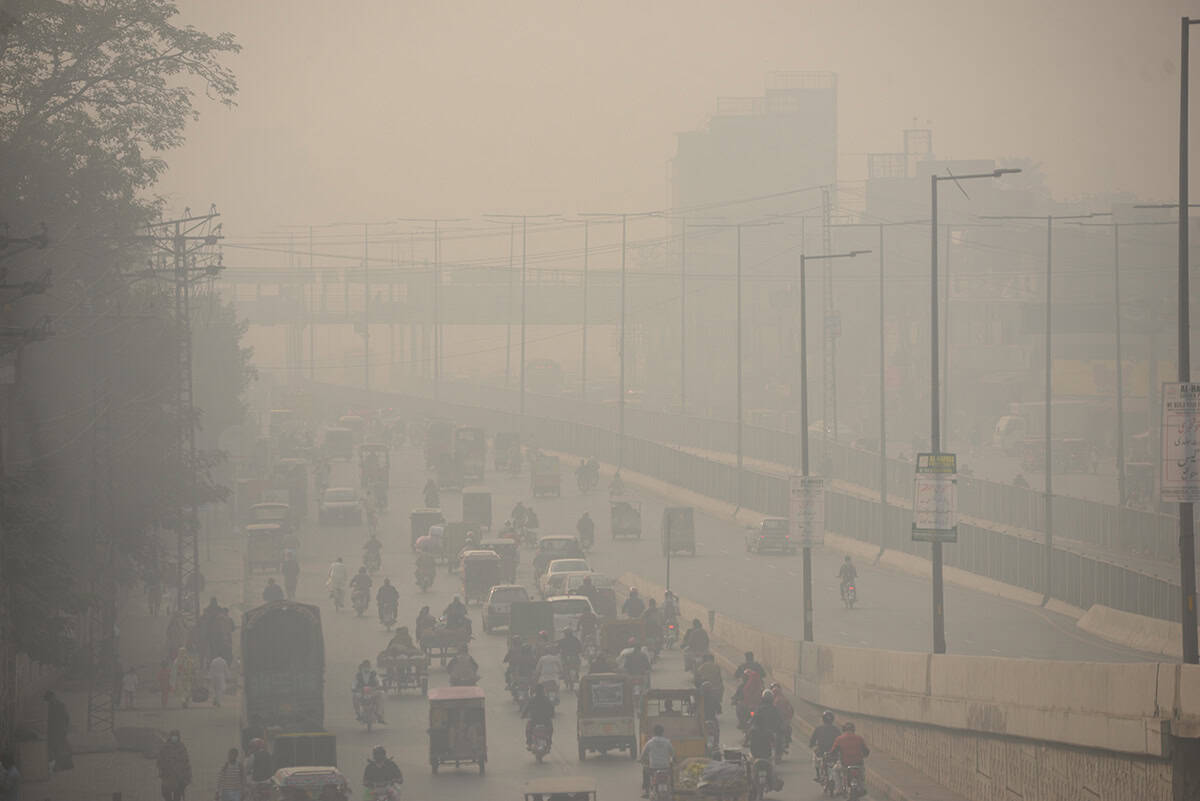
Jim Haywood, an atmospheric scientist at the University of Exeter, says that aerosols have two major cooling impacts on climate. The first is through the direct scattering of sunlight back out to space. The second is via the changes they induce in clouds.
When you add small pollution particles to clouds, explains Haywood, it creates “clouds that are made up of a larger number of small cloud droplets and those clouds are more reflective”. The shrinking in cloud droplet size can also reduce precipitation – adding more liquid water in clouds. The clouds therefore last longer, cover a greater area and become more reflective.
But if atmospheric aerosol concentrations are reduced, so too are these reflective, planet-cooling effects. “This masking effect by the aerosols is taken out and we unveil more and more of the full greenhouse warming,” says Quaas.
A good example of this is recent policy aimed at cleaning up shipping fuels by lowering sulphur concentrations. At the start of 2020 the International Maritime Organisation introduced regulations that slashed the limit on sulphur content in fuels from 3.5% to 0.5%.
Haywood explains that this has reduced the additional reflectivity that this pollution created in clouds and caused a sharp increase in global warming rates. “We’ve done some simulations with climate models, and they seem to be suggestive of at least three to four years acceleration of global warming,” he adds.
Overall models suggest that if we remove all the world’s polluting aerosols, we can expect to see around 0.4 °C of additional warming, says Quaas. He acknowledges that we must improve air quality “because we cannot just accept people dying and ecosystems deteriorating”. By doing so, we must also be prepared for this additional warming. But more work is needed, “because the current uncertainty is too large”, he continues. Uncertainty in the figures is around 50%, according to Quaas, which means that slashing aerosol pollution could cause anywhere from 0.2 to 0.6 °C of additional warming.
Haywood says that while current models do a relatively good job of representing how aerosols reduce cloud droplet size and increase cloud brightness, they do a poor job of showing how aerosols effect cloud fraction.
Cloud manipulation
The fact that aerosols cool the planet by brightening clouds opens an obvious question: could we use aerosols to deliberately manipulate cloud properties to mitigate climate change?
“There are more recent proposals to combat the impacts, or the worst of the impacts of global warming, through either stratospheric aerosol injection or marine cloud brightening, but they are really in their infancy and need to be understood an awful lot better before any kind of deployment can even be considered,” says Haywood. “You need to know not just how the aerosols might interact with clouds, but also how the cloud then interacts with the climate system and the [atmospheric] teleconnections that changing cloud properties can induce.”
Haywood recently co-authored a position paper, together with a group of atmospheric scientists in the US and Europe, arguing that a programme of physical science research is needed to evaluate the viability and risks of marine cloud brightening (Sci. Adv. 10 eadi8594).
A proposed form of solar radiation management, known as marine cloud brightening, would involve injecting aerosol particles into low-level, liquid marine clouds – mainly those covering large areas of subtropical oceans – to increase their reflectiveness (figure 4).
Most marine cloud-brightening proposals suggest using saltwater spray as the aerosol. In theory, when sprayed into the air the saltwater would evaporate to produce fine haze particles, which would then be transported by air currents into cloud. Once in the clouds, these particles would increase the number of cloud droplets, and so increase cloud brightness.
4 Marine cloud brightening
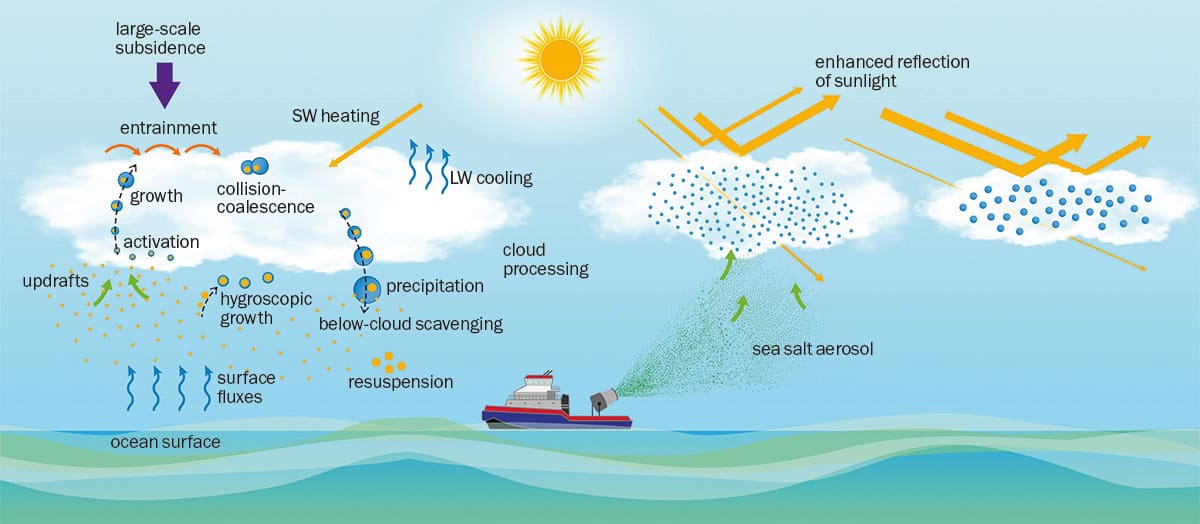
In this proposal, ship-based generators would ingest seawater and produce fine aerosol haze droplets with an equivalent dry diameter of approximately 50 nm. In optimal conditions, many of these haze droplets would be lofted into the cloud by updrafts, where they would modify cloud microphysics processes, such as increasing droplet number concentrations, suppressing rain formation, and extending the coverage and lifetime of the clouds. At the cloud scale, the degree of cloud brightening and surface cooling would depend on how effectively the droplet number concentrations can be increased, droplet sizes reduced, and cloud amount and lifetime increased.
Graham Feingold, research scientist at NOAA’s Chemical Laboratory in Boulder, Colorado, says that there are still unanswered questions on everything from particle generation to their interactions with clouds, and the overall impact on cloud brightness and atmospheric systems.
Feingold, an author on the position paper, says that a key challenge lies in predicting how additional particles will affect cloud properties. For instance, while more haze droplets might theoretically brighten clouds, it could also lead to unintended effects like increased evaporation or rain, which could even reduce cloud coverage.
Another difficult challenge is the inconstancy of cloud response to aerosols. “Ship traffic is really regular,” explains Feingold, “but if you look at satellite imagery on a daily basis in a certain area, sometimes you see really clear, beautiful ship tracks and other times you don’t – and the ship traffic hasn’t changed but the meteorology has.” This variability depends on cloud susceptibility to aerosols, which is influenced by meteorological conditions.
And even if cloud systems that respond well to marine cloud brightening are identified, it would not be sensible to repeatedly target them. “Seeding the same area persistently could have some really serious knock-on effects on regional temperature and rainfall,” says Feingold.
Essentially, aerosol injections into the same area day after day would create localized radiative cooling, which would impact regional climate patterns. This highlights the ethical concerns with cloud brightening, as such effects could benefit some regions while negatively impacting others.
Addressing many of these questions requires significant advances in current climate models, so that the entire process – from the effects of aerosols on cloud microphysics through to the larger impact on clouds and then global climate circulations – can be accurately simulated. Bridging these knowledge gaps will require controlled field experiments, such as aerosol releases from point sources in areas of interest, while taking observational data using tools like drones, aeroplanes and satellites. Such experiments would help scientists get a “handle on this connection between emitted particles and brightening”, says Feingold.
But physicists can only do so much. “We are not trying to push marine cloud brightening, we are trying to understand it,” says Feingold. He argues that a parallel effort to discuss the governance of marine cloud brightening is also needed.
In recent years, much progress has been made in determining the impact of clouds, when it comes to regulating our planet’s climate, and their importance in climate modelling. “While major advances in the understanding of cloud processes have increased the level of confidence and decreased the uncertainty range for the cloud feedback by about 50% compared to AR5 [IPCC report], clouds remain the largest contribution to overall uncertainty in climate feedbacks (high confidence),” states the IPCC’s latest Assessment Report (AR6), published in 2021. Physicists and atmospheric scientists will continue to study how cloud systems will respond to our ever-changing climate and planet, but ultimately, it is wider society that needs to decide the way forward.
